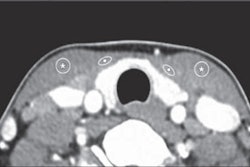CHICAGO - Educating clinical house staff about CT radiation does not necessarily change ordering patterns for the exam, according to research presented Monday at the American Roentgen Ray Society (ARRS) meeting. But it does give clinicians information they can share with patients concerned about radiation dose.
Dr. Jeanne Horowitz at Northwestern University and colleagues assessed whether educating clinical house staff about CT radiation -- in the form of a short lecture -- would change the number and type of CT scans ordered, the use of alternative imaging exams, and whether staff used information from the lectures to educate their patients.
"[Nonradiology] clinicians order CT scans and have to respond to patient concerns," she told session attendees. "But they don't have background training in radiation, which can lead to confusion for both clinicians and patients and the potential for over- or underuse of CT. As radiologists, we have a duty to educate referring physicians about CT scan radiation issues."
Horowitz addresses three main issues: why patients ask about radiation, what Northwestern is doing to reduce radiation dose, and what doctors can tell their patients about radiation, Horowitz said.
Surveys were completed by 21 of 37 clinical house staff who attended the lecture. Of these 21 clinicians, 10 were urology residents and 11 were orthopedic residents, according to Horowitz. For 90% of respondents, the number of CT scans ordered remained the same after the lecture, while for the remaining 10%, the number of CT scans ordered decreased.
Thirty-three percent of all respondents reported greater use of other imaging modalities after the lecture, such as MRI (24%) and ultrasound (19%). And the majority of study participants (83%) used information they had learned from the lecture to answer patients' questions about radiation, Horowitz said.
She acknowledged that the study's limitations included its small sample size and the fact that participants were house staff rather than attending physicians. But education like this is a good start, Horowitz told ARRS attendees.
"I've given this talk a number of times to different groups, whether internal medicine doctors, radiologists, or residents, and each time I tailor it to what exams they're ordering," she said. "For internal medicine, I emphasize the American College of Radiology's Appropriateness Criteria, while for orthopedic [physicians], I focus on their musculoskeletal CT issues. It helps to adapt the information to your audience."
It's all good?
In a related study presented in the same ARRS session, Dr. Alisa Kanfi and Dr. Michael O'Loughlin, of Hartford Hospital in Connecticut, evaluated CT radiation dose in the outpatient setting before and after implementing dose reduction techniques. Specifically, they evaluated dose at Jefferson Radiology, a practice that includes 50 radiologists and serves communities throughout Connecticut.
Kanfi also explored how dose reduction techniques correlated with radiologist satisfaction with image quality, finding that the satisfaction rate for overall image quality was 90% both before and after dose reduction.
Kanfi reviewed 3,913 CT scans over three months, analyzing the data by exam type and office location, she said. She sent participating radiologists a dose image quality/satisfaction survey before and after dose reduction strategies had been put in place.
Dose reduction techniques included the following:
- Automatic dose modulation, based on patients' body size
- Pediatric low-dose protocols
- Bismuth shielding
- Increasing the noise index
- Decreasing the kVp on selected exams
- Increasing the gantry rotation speed on selected exams
Kanfi and O'Loughlin found statistically significant reductions in dose in several CT exams:
Dose reduction by exam type
|
Although the radiologists' satisfaction rate for overall image quality remained unchanged at 90% for both pre- and postdose reduction images, 47% of respondents did feel that the dose reduction affected their ability to make accurate diagnoses in several cases, Kanfi said.
"We found that radiologists were willing to accept noisier images for the benefit of patients, even though some felt that the lower dose may have limited diagnostic accuracy," she told session attendees.





















